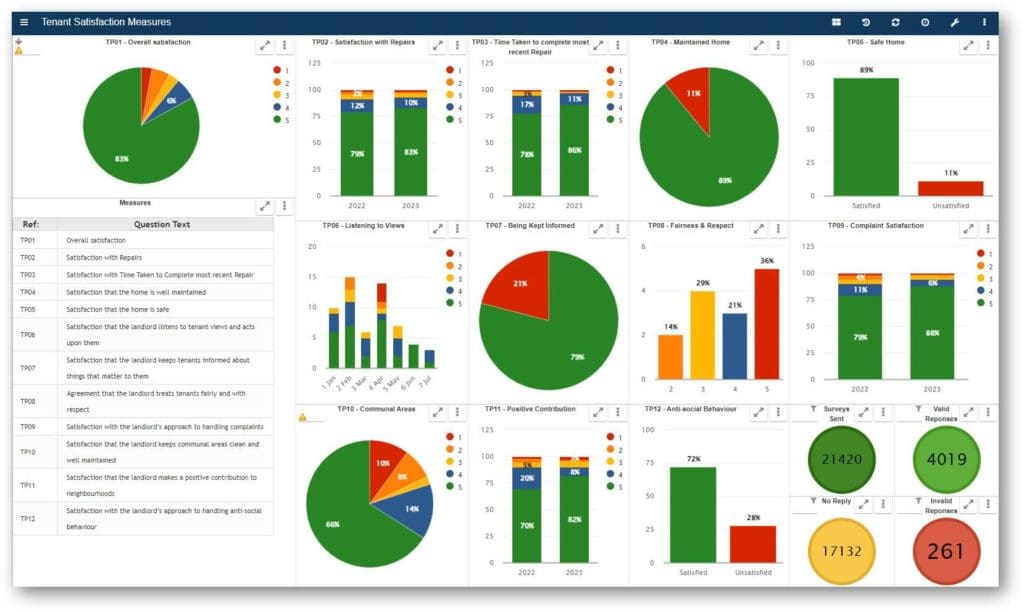Published in March 2023 by the UK government, the Tenant Satisfaction Measures Standard was created by the Regulator of Social Housing. This new system has been introduced to assess how well social housing landlords in England are providing good quality homes and services.
Here, we take a look at what the new tenant satisfaction measures are and why the ROCC Tenant Satisfaction Dashboard has been created in light of this announcement.
What are the new Tenant Satisfaction Measures?
Created to analyse the performance of social housing landlords in England, these revised standards involve a set of tenant satisfaction measures (TSMs) that social housing landlords must report on. This allows people to measure and understand how well landlords are doing at providing quality homes and services.
The new system requires all registered social housing providers to collect and report annually on their performance to ensure tenants receive greater transparency about how landlords are performing. The information must meet the regulator’s requirements that are set out in the TSMs.
In total, there are 12 TSMs that will be obtained through tenant surveys by providers and 10 landlord management information measures. To summarise, these measures include:
- Keeping properties in good repair.
- Maintaining building safety.
- Effective complaints handling.
- Respectful and helpful tenant engagement.
- Responsible neighbourhood management.
As the new measures came into force on the 1st of April 2023, landlords with 1,000
or more homes will send their first year of tenant satisfaction measures data in the summer of 2024. By autumn of the same year, the first year of tenant satisfaction measures data will be ready to be published.
How will the tenant satisfaction measures work?
The aim of the TSMs is to make landlords’ performance more visible to tenants and ensure they are held accountable for any shortcomings. Each measure should be able to tell tenants something about the landlord, so they can use these findings to compare landlords and work out how they are performing in key areas.
Below is a graphic that details exactly how the TSMs work.

Source: GOV.UK
As well as these measures, the Regulator of Social Housing has also published:
- A TSMs standard that requires landlords to collect, process and publish the information needed for the measures.
- A set of requirements that tells landlords how they must collect and publish the information, so that different landlords’ information is consistent and can be compared.
- Guidance about the submission of TSMs information to the regulator and how they will use the data they receive.
All of these measures and publications have been introduced to make a meaningful difference to tenants and ensure that the behaviour of landlords can be regulated.
You can find out about the TSMs using this summary document or alternatively find more detailed information here.
Measuring tenant satisfaction using ROCC Core
Following the release of the government’s TSMs, ROCC has been looking at how to best represent these responses graphically using our ROCC Core dashboard view.
We feel that in order to meet these new requirements it’s key to have a single point of truth that fully reflects these results and allows this information to be easily acted on. It’s also important that the results can be broken down using multiple filters so that further action can be quickly taken to reach out to dissatisfied tenants as soon as possible.
With this in mind, the ROCC Tenant Satisfaction Dashboard was produced to report on the results of each individual question within the surveys (see image below).

This data source can be provided by an existing system, a survey from a mobile application or manually fed back and entered. The ROCC Dashboard is database agnostic and can be plugged into over 35 different data sources (all working together) at the push of a single button.
Matt Watts, Head of Customer Success, ROCC, said: “The key factor in collecting data on customer satisfaction is two-fold. Not only is it important that it’s easy for the customer to provide this information, but it must be easy for the collectors of this data to be able to report and view the information. Ease of use allows us to break the data down, address any issues before they become major problems and act on individual responses as-and-when required.
“The ROCC Dashboarding features in ROCC Core allow for simple setup, ease of use and a single place to analyse this data. From either an overall picture of responses to a single survey, our dashboard allows quick, easy and exportable access to the results of any customer satisfaction measures in a visually pleasing and uncomplicated environment.”
For more information about how you can use ROCC Core to measure customer satisfaction, get in touch with a friendly member of our team today.
